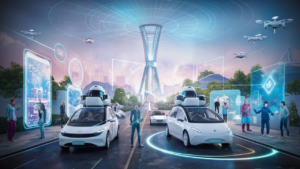In today’s hyper-connected world, the advent of 5G technology has sparked a revolution in the realm of telecommunications. Simply put, 5G stands for the fifth generation of wireless technology, promising lightning-fast speeds, ultra-low latency, and unparalleled connectivity. Unlike its predecessors, 5G infrastructure is not merely an upgrade but a quantum leap forward, poised to reshape industries and redefine our digital landscape.

What is 5G?
At its core, 5G represents a paradigm shift in how we transmit and receive data wirelessly. Unlike 4G LTE, which primarily focused on delivering faster mobile internet speeds, 5G encompasses a broader spectrum of capabilities, including support for massive machine-type communications (mMTC), ultra-reliable low-latency communications (URLLC), and enhanced mobile broadband (eMBB). Read more
Importance of 5G Infrastructure
The significance of 5G infrastructure cannot be overstated. It serves as the backbone of the digital economy, empowering businesses, governments, and consumers with unprecedented connectivity and bandwidth. From powering smart cities to enabling autonomous vehicles, 5G lays the foundation for a future where virtually everything is interconnected.
Evolution from 4G to 5G
The transition from 4G to 5G represents a monumental leap forward in terms of speed, capacity, and reliability. While 4G networks typically offer download speeds of up to 100 Mbps, 5G has the potential to deliver peak speeds exceeding 10 Gbps, ushering in an era of real-time communication and immersive experiences.
Key Components of 5G Infrastructure
To understand the inner workings of 5G technology, it’s essential to delve into its key components, each playing a crucial role in delivering seamless connectivity and performance. READ MORE
Radio Access Network (RAN)
At the heart of every 5G network lies the Radio Access Network (RAN), responsible for transmitting and receiving wireless signals between mobile devices and base stations. Unlike traditional RAN architectures, which rely on centralized processing, 5G leverages distributed RAN (DRAN) and virtual RAN (vRAN) technologies to enhance flexibility and scalability.
Core Network
The Core Network serves as the central nervous system of the 5G infrastructure, orchestrating the flow of data between various network elements and ensuring seamless connectivity across diverse devices and applications. Powered by cloud-native architecture, the 5G core enables network slicing, network function virtualization (NFV), and edge computing capabilities.

Edge Computing
One of the defining features of 5G technology is its integration with edge computing, enabling low-latency processing and real-time data analytics at the network edge. By bringing computation closer to the point of data generation, edge computing minimizes latency and bandwidth consumption, paving the way for immersive experiences and mission-critical applications.
Massive MIMO (Multiple-Input, Multiple-Output)
Massive MIMO represents a breakthrough in wireless communication technology, leveraging a multitude of antennas to transmit and receive data simultaneously. By harnessing spatial diversity and beamforming techniques, Massive MIMO enhances spectral efficiency and network capacity, enabling 5G networks to support a higher density of connected devices with improved throughput.
Benefits of 5G Infrastructure
The deployment of 5G infrastructure unlocks a myriad of benefits, revolutionizing how we communicate, collaborate, and innovate in the digital age.
Faster Speeds
With 5G, users can experience blazing-fast download and upload speeds, facilitating seamless streaming, gaming, and file transfers on mobile devices and IoT gadgets.
Lower Latency
5G technology significantly reduces latency, the time it takes for data to travel between devices and servers, enabling real-time communication and immersive applications such as virtual reality (VR) and augmented reality (AR).
Increased Capacity
By leveraging advanced antenna technologies and spectrum allocation techniques, 5G networks can support a higher density of connected devices, paving the way for the Internet of Things (IoT) and smart city initiatives.
Enhanced Connectivity
With 5G, connectivity becomes ubiquitous, extending beyond urban centers to remote areas and underserved communities, bridging the digital divide and empowering individuals with access to critical services and information.
Applications and Use Cases
The versatility of 5G technology extends far beyond faster download speeds and lower latency, unlocking a wealth of innovative applications and use cases across diverse industries.
Internet of Things (IoT)
5G infrastructure forms the backbone of the IoT ecosystem, enabling seamless connectivity and data exchange between billions of interconnected devices, ranging from smart appliances to industrial sensors.
Autonomous Vehicles
Self-driving cars rely on 5G connectivity to navigate roads safely and efficiently, leveraging real-time data streams and high-precision positioning systems to avoid collisions and optimize traffic flow.
Virtual Reality (VR) and Augmented Reality (AR)
5G technology unlocks new possibilities for immersive experiences, powering VR and AR applications that blur the line between the physical and digital worlds, from interactive gaming to remote collaboration and training.
Telemedicine
In the realm of healthcare, 5G infrastructure enables telemedicine solutions that transcend geographical barriers, connecting patients with healthcare providers in real-time and facilitating remote consultations, diagnosis, and treatment.
Challenges and Considerations
Despite its transformative potential, the widespread adoption of 5G infrastructure is not without its challenges and considerations, ranging from technical hurdles to regulatory constraints.
Coverage and Deployment Challenges
Expanding 5G coverage requires significant investments in infrastructure, including the deployment of small cells and mmWave antennas, particularly in rural and underserved areas where connectivity is limited.
Security Concerns
As 5G networks become more interconnected and data-intensive, cybersecurity emerges as a paramount concern, with potential vulnerabilities in network architecture and device ecosystems posing threats to privacy and data integrity.
Regulatory Hurdles
The rollout of 5G infrastructure is subject to regulatory approval and compliance with spectrum licensing requirements, which vary across different regions and jurisdictions, potentially delaying deployment and interoperability.
Infrastructure Costs
Building and maintaining 5G infrastructure entail substantial costs for network operators and service providers, including spectrum acquisition fees, equipment procurement, and ongoing maintenance, which may impact the affordability and accessibility of 5G services.
Global Adoption and Rollout
Despite these challenges, 5G adoption continues to gain momentum worldwide, driven by a combination of technological advancements, market demand, and government initiatives.
Leading Countries in 5G Deployment
Countries such as South Korea, China, and the United States have emerged as frontrunners in 5G deployment, leveraging their technological prowess and economic resources to build robust networks and drive innovation across various sectors.
Timeline for Worldwide Implementation
While 5G networks are already operational in many urban centers and metropolitan areas, the full-scale rollout of 5G infrastructure is expected to unfold gradually over the coming years, with projections estimating widespread adoption by 2025.
Impact on Industries and Economies
The proliferation of 5G technology is poised to catalyze economic growth and drive digital transformation across industries, from manufacturing and logistics to healthcare and entertainment, unlocking new revenue streams and business opportunities.
Future Prospects and Innovations
Looking ahead, the future of 5G holds boundless possibilities, paving the way for a new era of connectivity, innovation, and societal progress.
6G and Beyond
Even as 5G continues to evolve, researchers and industry experts are already exploring the potential of 6G technology, envisioning networks that are even faster, smarter, and more ubiquitous, with capabilities beyond our current imagination.
Integration with Emerging Technologies
5G infrastructure will serve as the backbone of emerging technologies such as artificial intelligence (AI), blockchain, and quantum computing, enabling seamless integration and interoperability across heterogeneous ecosystems.
Societal Implications and Ethical Considerations
As 5G permeates every aspect of our lives, it raises profound questions about privacy, surveillance, and digital equity, necessitating thoughtful deliberation and proactive measures to ensure ethical and inclusive deployment.
Conclusion
In conclusion, the marvels of 5G infrastructure are poised to revolutionize our world, unlocking unprecedented speed, connectivity, and innovation. From powering smart cities to enabling autonomous vehicles and transforming healthcare delivery, 5G holds the key to a future where anything is possible.
FAQs
- What makes 5G different from previous generations of wireless technology? 5G offers significantly faster speeds, lower latency, and increased capacity compared to 4G LTE, enabling a wide range of new applications and use cases beyond traditional mobile broadband.
- How will 5G impact everyday life for consumers? 5G will enable seamless streaming, gaming, and communication on mobile devices, as well as facilitate innovative applications such as IoT, VR, AR, and telemedicine.
- Are there any health concerns associated with 5G technology? While some studies have raised concerns about potential health effects of electromagnetic radiation from 5G infrastructure, the consensus among scientific experts is that 5G is safe within established regulatory limits.
- What industries stand to benefit the most from 5G infrastructure? Industries such as healthcare, manufacturing, transportation, and entertainment are expected to see significant benefits from 5G technology, ranging from improved efficiency and productivity to new revenue opportunities.
- What are some of the challenges hindering the widespread adoption of 5G? Challenges include coverage and deployment issues, security concerns, regulatory hurdles, and infrastructure costs, which may impact the pace and scale of 5G rollout in different regions.



